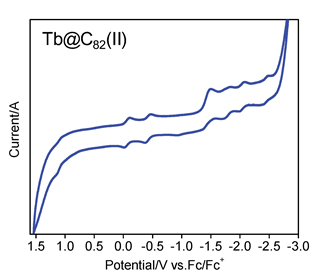| [1] (a) Jiang, L.; Wang, T.-S.; Shu, C.-Y.; Wang, C.-R. Sci. China-Chem. 2011, 41, 629 (in Chinese). (蒋礼, 王太山, 舒春英, 王春儒, 中国科学:化学, 2011, 41, 629.)
(b) Wang, Z.; Nakanishi, Y.; Noda, S.; Niwa, H.; Zhang, J.; Kitura, R.; Shinohara, H. Angew. Chem., Int. Ed. 2013, 125, 11986.
(c) Nakanishi, Y.; Omachi, H.; Matsuura, S.; Miyata, Y.; Kitaura, R.; Itami, K.; Shinohara, H. Angew. Chem., Int. Ed. 2014, 53, 3102.
[2] (a) Xie, Q.; Arias, R.; Echegoyen, L. J. Am. Chem. Soc. 1993, 775, 9818.
(b) Alexey, A.; Shangfeng, Y.; Lothar, D. Chem. Rev. 2013, 113, 5989.
[3] Lu, X.; Slanina, Z.; Akasaka, T.; Tsuchiya, T.; Mizorogi, N.; Nagase, S. J. Am. Chem. Soc. 2010, 132, 5896.
[4] Suzuki, T.; Kikuchi, K.; Oguri, F.; Nakao, Y.; Suzuki, S.; Achiba, Y.; Yamamoto, K.; Funasaka, H.; Takahashi, T. Tetrahedron 1996, 52, 4973.
[5] Lu, X.; Feng, L.; Akasaka, T.; Nagase, S. Chem. Soc. Rev. 2012, 41, 7723.
[6] (a) Akasaka, T.; Kono, T.; Matsunaga, Y.; Wakahara, T.; Nakahodo, T.; Ishitsuka, M. O.; Maeda, Y.; Tsuchiya, T.; Kato, T.; Liu, M. T. H.; Mizorogi, N.; Slanina, Z.; Nagase, S. J. Phys. Chem. A 2008, 112, 1294.
(b) Suzuki, T.; Maruyama, Y.; Kato, T.; Kikuchi, K.; Achiba, Y. J. Am. Chem. Soc. 1993, 115, 11006.
[7] (a) Akasaka, T.; Okubo, S.; Kondo, M.; Maeda, Y.; Wakahara, T.; Kato, T.; Suzuki, T.; Yamamoto, K.; Kobayashi, K.; Nagase, S. Chem. Phys. Lett. 2000, 319, 153.
(b) Kikuchi, K.; Nakao, Y.; Suzuki, S.; Achiba, Y.; Suzuki, T.; Maruyama, Y. J. Am. Chem. Soc. 1994, 116, 9367.
[8] Xu, J. X.; Li, M. X.; Shi, Z. J.; Gu, Z. N. Chem. Eur. J. 2005, 12, 562.
[9] (a) Bao, L.-P.; Pan, C.-W.; Slanina, Z.; Uhlik, F.; Akasaka, T.; Lu, X. Angew. Chem., Int. Ed. 2016, 55, 9234.
(b) Maeda, Y.; Matsunaga, Y.; Wakahara, T.; Takahashi, S.; Tsuchiya, T.; Ishitsuka, M.; Hasegana, T.; Akasaka, T.; Liu, M.; Kokura, K.; Horn, E.; Yoza, K.; Kato, T.; Okubo, S.; Kobayashi, K.; Nagase, S.; Yamamoto, K. J. Am. Chem. Soc. 2004, 126, 6858.
[10] Fan, L.-Z.; Wu, Y.-Q.; Yang, S.-F.; Yang, S.-H. Acta Chim. Sinica 2004, 62, 2213 (in Chinese). (范楼珍, 吴月芹, 杨尚峰, 杨世和, 化学学报, 2004, 62, 2213.)
[11] Wang, W.; Ding, J.; Yang, S.-F.; Li, X.-Y. Electrochemical Properties of 4f-Block Metallofullerenes. In Fullerenes. Recent Advances in the Chemistry and Physics of Fullerenes and Related Materials, Vol. 4, Eds.: Kadish, K. M.; Ruoff, R. S., Electrochemical Society, Pennington, 1997, p. 417.
[12] (a) Liu, F.-P.; Wang, S.; Guan, J.; Wei, T.; Zeng, M.; Yang, S.-F. Inorg. Chem. 2014, 53, 5201.
(b) Liu, F.-P.; Gao, C.-L.; Deng, Q.-M.; Zhu, X.-J.; Kostanyan, A.; Westerstrom, R.; Wang, S.; Tan Y.-Z.; Tao, J.; Xie, S.-Y.; Popov, A.; Greber, T.; Yang, S.-F. J. Am. Chem. Soc. 2016, 138, 14764.
[13] Hino, S.; Umishita, K.; Iwasaki, K.; Aoki, M.; Kobayashi, K.; Nagase, S.; Dennus, T.-J.-S.; Nakane, T.; Shinohara, H. Chem. Phys. Lett. 2001, 337, 65. |
